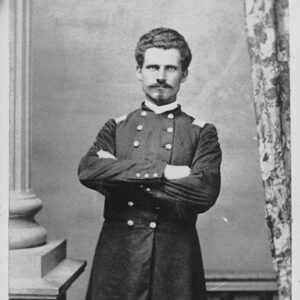calsfoundation@cals.org
Robert Francis Catterson (1835–1914)
Robert Francis Catterson was an officer in the Union army during the Civil War. Ending the war as a brigadier general, he led militia units in Arkansas after the adoption of the 1868 constitution. He also fought in the Brooks-Baxter War and served as the mayor of Little Rock (Pulaski County).
Robert Catterson was born on March 22, 1835, in Beech Grove, Indiana, the son of Patrick and Sarah Catterson. His father died about five years after his birth, and Catterson was raised by his mother alongside his five siblings. He attended local schools and then Adrian College in Michigan and Cincinnati Medical College. Upon the completion of his studies, he opened a medical practice in Rockville, Indiana.
Catterson joined the Union army at the outbreak of war. Enlisting in the Fourteenth Indiana Infantry on April 23, 1861, he was promoted to both first sergeant and second lieutenant in June. In March 1862, he was promoted to first lieutenant and, later the same month, fought in the First Battle of Kernstown. A promotion to captain followed in May, and he continued to see service in the Eastern Theater before being wounded at the Battle of Antietam in September 1862. After his return to active duty, Catterson was promoted to the rank of lieutenant colonel of the Ninety-Seventh Indiana Infantry, a new unit that was organized in September 1862. Catterson was promoted to colonel of the unit in November, and the regiment guarded rail lines in Tennessee before participating in the siege of Vicksburg, Mississippi. The regiment saw further action at Chattanooga, Missionary Ridge, and in the Atlanta Campaign. After his brigade commander was wounded in November 1864, Catterson led the brigade for the remainder of the war. He was promoted to brigadier general of volunteers on May 31, 1865, and left active service on January 15, 1866.
Catterson moved to Arkansas after leaving the army and worked as a cotton speculator. Failing in that venture, he became involved in politics and was elected to serve a single term in the Arkansas House of Representatives in 1868. Catterson allied himself with Governor Powell Clayton. Violence broke out in 1868 in numerous counties across the state after the adoption of the 1868 constitution. Clayton placed Catterson in command of militia units tasked with enforcing martial law to prevent attacks on freedmen. Joining units in Howard County, Catterson led operations in southwestern and southern Arkansas from November 1868 until early 1869.
The following year, Catterson was named by Clayton as the U.S. marshal for the Eastern District of Arkansas. Confirmed by the Arkansas State Senate on March 24, he held the position until 1872. While holding this position, he lived with the family of Senator Alexander McDonald in the McDonald-Newton-Wait House. In 1872, he was elected as the mayor of Little Rock, serving until 1874.
Around 1871, Catterson married Louisa Ellen Withall, and the couple had two daughters.
In 1874, he led the forces of Joseph Brooks during the Brooks-Baxter War. As a fellow “carpetbagger,” Catterson led the forces in a military stand-off against forces loyal to Elisha Baxter in Little Rock. When Baxter was finally declared the winner, Catterson disbanded his militia units and apparently left the state.
After stepping down from his militia command and leaving office, Catterson moved to Chicago, Illinois, and also lived in Minnesota and Kansas before moving to San Antonio, Texas, by 1910.
Catterson died in San Antonio on March 30, 1914. His wife died on February 17, 1922. They are buried in the San Antonio National Cemetery.
For additional information:
Atkinson, James H. “The Arkansas Gubernatorial Campaign and the Election of 1872.” Arkansas Historical Quarterly 1 (Winter 1942): 307–321.
Moneyhon, Carl. The Impact of the Civil War and Reconstruction on Arkansas: Persistence in the Midst of Ruin. Baton Rouge: Louisiana State University Press, 1993.
Staples, Thomas. Reconstruction in Arkansas, 1862–1874. Gloucester, MA: Peter Smith, 1964.
Warner, Ezra. Generals in Blue: The Lives of Union Commanders. Baton Rouge: Louisiana State University Press, 1964.
Woodward, Earl F. “The Brooks and Baxter War in Arkansas, 1872–1874.” Arkansas Historical Quarterly 30 (Winter 1971): 315–336.
David Sesser
Henderson State University
 Civil War through Reconstruction, 1861 through 1874
Civil War through Reconstruction, 1861 through 1874 Military
Military Politics and Government
Politics and Government Robert Catterson
Robert Catterson 




Comments
No comments on this entry yet.